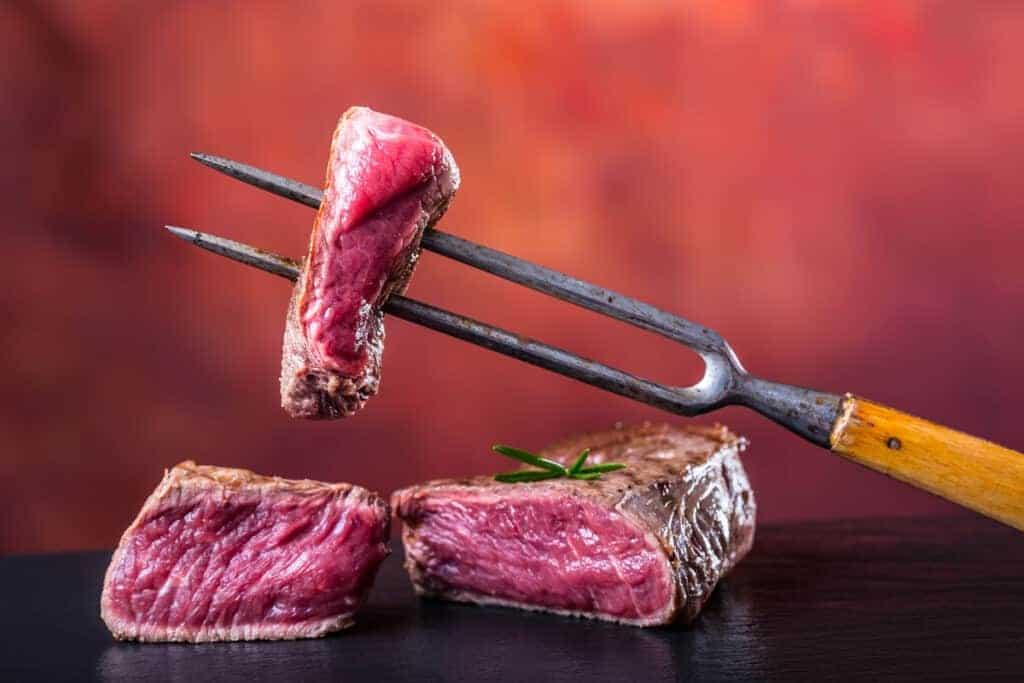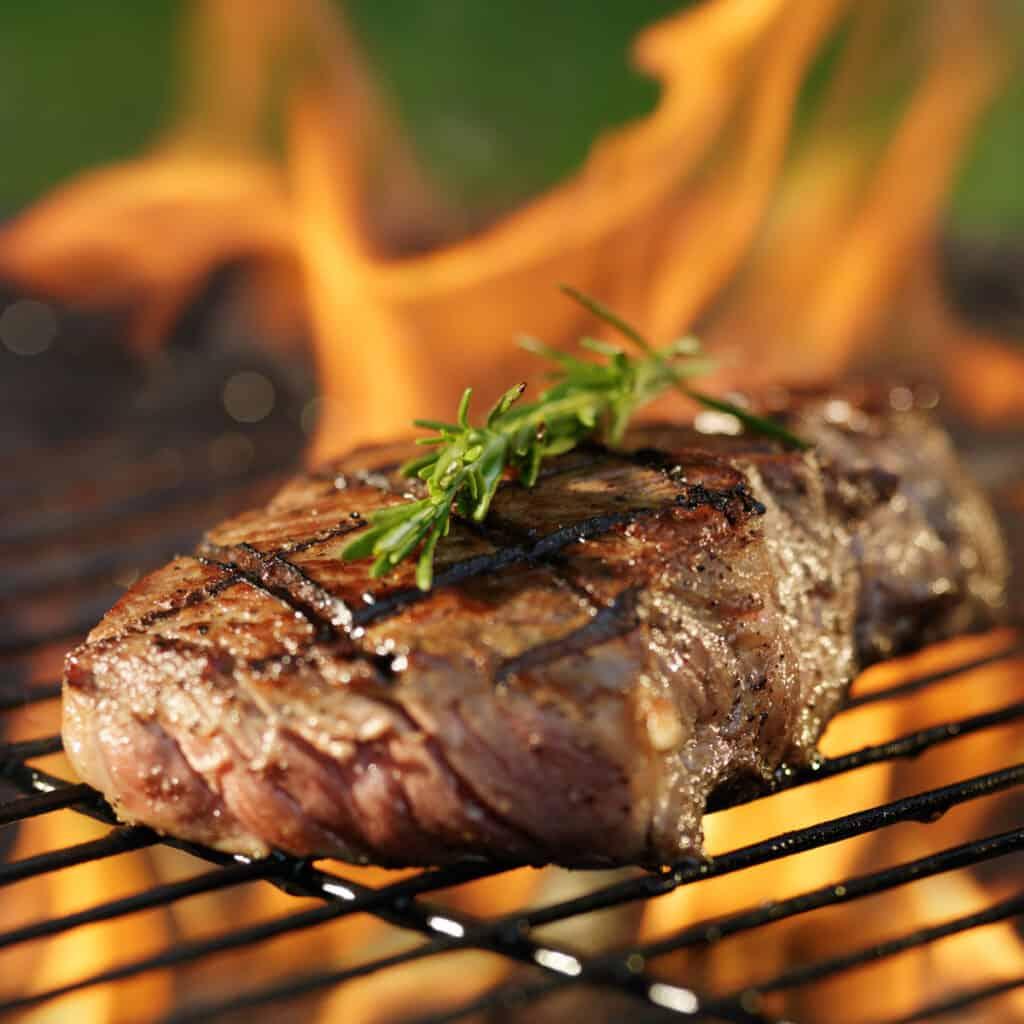Grilled steak is a delicacy for carnivores, but it can be hard to get it right. Cooking meat over an open flame requires finesse and advance planning. Here’s our ultimate guide on how long to grill steak at 350 degrees.
How Long to Grill Steak at 350
When you set the grill temperature to 350 degrees, a steak that measures 1 inch thick should take about 5 minutes per side to cook to medium-rare. If your steaks are thicker, or if you prefer the steak cooked to medium or medium-well, you’ll need to allow for a little more time.
About Steak Serving Temperatures
Before you learn how long to grill steak at 350 degrees—or any temperature—you’ll need to determine how you’d like the steak cooked.
When people ask “how would you like your steak?”, they’re asking about the internal temperature. The texture and flavor of the meat can vary, depending on how long it was exposed to the heat. So it’s important to understand the basics.
Blue-Rare
Blue-rare steak is not common, but some die-hard steak enthusiasts prefer it this way. The term refers to steak that’s seared quickly on either side and still mostly raw in the center.
When it’s cooked to blue-rare, steak should have a cool, dark red interior surrounded by a lightly charred crust. The internal temperature will read 115 degrees. If it’s cooked any harder, then it may qualify as a rare steak, but not blue-rare.
Rare
Tender and lean steaks such as filet mignon are at their best when served rare, though medium-rare (see below) is also a suitable temp. In the window between 120 and 130 degrees, the steak will be soft to the touch, with seared edges and a warm red center.
This temperature range is better for lean steaks because the fats have not yet begun to melt at this point. For example, if you were to eat a very rare ribeye, the marbling wouldn’t have had a chance to suffuse the meat with flavor and texture.
Medium-Rare
This classification is reserved for steaks that have cooked to 130-135 degrees in the center. The meat will have a tender texture and ideal juiciness, with a firm, well-seared exterior. Meanwhile, the center should be warm and pinkish red.
When steak is cooked to medium-rare, it will often leave red juices behind on the plate. Don’t be turned off by the sight—although the substance resembles blood, it’s actually a blend of water and a protein known as myoglobin.
Medium
The temperature range for medium steaks falls between 135 and 155. At this point, the meat will be slightly springy to the touch, with a hot pink center and a nicely browned crust on the outside.
Be aware that while medium is the preferred temp for many folks who don’t want to see a lot of red liquid on the plate, the steak itself has lost a good deal of moisture at 150 degrees. Keep that in mind when you’re testing the temperature.
Medium-Well
If you ask for your steak to be cooked medium-well, many grilling enthusiasts will do a double take. Steak that’s cooked to 155-165 degrees is browned all the way through, with perhaps a hint of pink running through the center. It will also be fairly dry.
A medium-well steak will have minimal flavor compared to one that’s cooked medium-rare. It will also be tougher to chew. We would advise against letting your steak get to this point if you can avoid it.
Well-Done
Once the steak has cooked to 170 degrees or more, it will have no pink remaining in the middle. The meat will also be tough, dry, and lacking in flavor.
If there’s anyone on your guest list who prefers their steak well-done, you should cook it slowly to prevent the exterior from burning. Also, bear in mind that potentially carcinogenic compounds can form on meat that’s cooked to these temperatures.
How To Test Steak Temperature

There’s only one way to be certain whether the steak has cooked to the temperature you’re looking for, and that’s by using a meat thermometer.
If you don’t yet own an instant-read meat thermometer, there’s no better time to invest in one. They’re inexpensive, easy to use, and invaluable when it comes to perfectly grilled or smoked meat.
Remember that the meat will continue to cook due to residual heat once you take it off the grill. You should try to remove it from the heat when it’s within 5 to 10 degrees of your target temperature.
Aim for 5 degrees below your target temp if you prefer your steak medium to medium-well, or 10 degrees below if you want to keep it on the rarer side. Once you’ve transferred the meat to a plate, tent it with foil to keep it warm while it rests.
Alternate Methods
Though we strongly advise using a thermometer to test your steak’s internal temperature, there are a couple of shortcuts you can employ along the way.
Timing
First of all, you can use the timing guide we’ve provided below. This should tell you when the steak is ready to be turned over and give you a rough estimate as to when you’ll be able to take it off the heat.
The Finger Test
Chefs in restaurants often use the “finger test” to tell them when the steak is approaching the desired doneness. Though it’s not foolproof, it comes in handy for a couple of reasons.
Inserting a thermometer probe into the steak causes some of the juices to run out. It can also mess with the presentation, which is important in a restaurant.
There’s also the fact that these chefs prepare dozens, if not hundreds, of steaks per week. That gives them a lot of opportunities to practice.
To employ the finger test, open the palm of your hand and relax your fingers. Then use the index finger of your other hand to press against the fleshy spot between your thumb and the base of your palm. This will demonstrate what a raw steak feels like.
Next, press your thumb and pinky finger together. Touch your opposite index finger to the same spot beneath your thumb. This firm texture is what a well-done steak feels like when you press down on the surface.
Your next step will be to find out what a medium steak feels like. When your thumb is pressed against your ring finger rather than your pinky, the area beneath your thumb should resemble the texture of a steak that’s cooked to medium.
Similarly, when your middle finger is the one that’s pressed against your thumb, that fleshy area will have a bit more give to it. That’s what a medium-rare steak feels like.
If you want to demonstrate the firmness of a steak that’s cooked to rare, touch your index finger to your thumb. The flesh that connects these two fingers will have quite a bit of flexibility, but not as much as when your fingers were completely relaxed.
How Long to Grill Steak at 350 Degrees
The total cooking time depends on the thickness of the steak you’re cooking, as well as your desired temperature. For the sake of consistency, let’s assume that you’re grilling a steak that measures 1 inch thick.

At 350 degrees, the following time frames should give you the temperature that you’re going for:
- Blue-Rare: Sear for about 1 minute per side
- Rare: 3 to 4 minutes per side
- Medium-Rare: 5 minutes per side
- Medium: 6 to 8 minutes per side
- Medium-Well: 8 to 9 minutes per side
- Well-Done: 12 to 15 minutes on the first side, then another 10 minutes after turning
Note that if your steak measures more than 1 inch thick, you’ll need to cook them for a minute or two more per side in order to achieve the desired results.
The Bottom Line
Though we prefer to set the temperature a bit higher when grilling steaks, 350 degrees is hot enough to get a good sear on the meat. It will also allow the fat to render more slowly, giving cuts like ribeye a lovely juicy texture.
Best of luck, and happy grilling!



